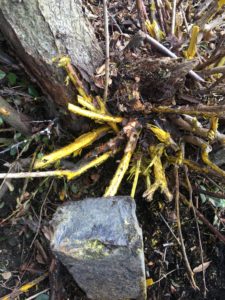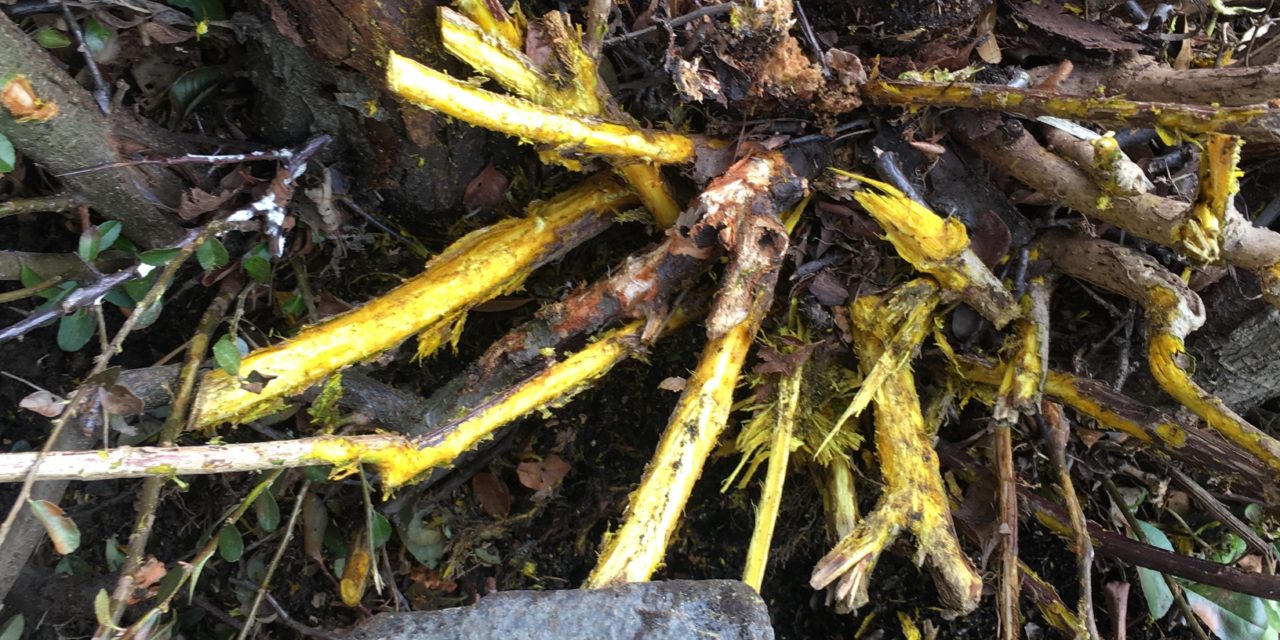As one might imagine, you can’t write two blog posts in a row about forgiveness without then finding yourself smack up against a wall of hurt and anger and amorphous blobby emotions directed at a particular person but also mostly at yourself. Hello, wall. I write blog posts about forgiveness.
The situation is so tangled at this point that I don’t know if I’m angry at the person, for their actions and existence, or at what their presence represents, which includes a large hairball of my own regret, frustration, and inaction. It has been going on for over two years. I have been practicing “just forgive” for at least half of that time. Sometimes I think it’s working. Sometimes I just rage.
In my back yard is a thorny tree I have yet to identify. Its trunk wasn’t properly pruned, so there are several branches growing up out of the ground alongside the main trunk. The tree flowers in the spring, and it is just sturdy enough for birds to land at the tips of the branches, but it also has two inch long spikes at regular intervals. For a year I thought the trunk and branches were thorny and wanted to cut the whole thing down, but last season I realized that it’s not that bad of a tree, a decent tree really, it just has a Japanese barberry bush growing out of the dead center of its trunk(s).
Let me tell you how much I hate Japanese barberry: it’s invasive, because deer won’t eat it. It’s ubiquitous. Its seeds have an 80-90% germination rate. It’s covered in thorns, really tiny ones that just hurt so bad. Kids get stuck in it and howl. Grownups get stuck in it and say profane words. It’s a perfect environment for ticks. I mean, ticks looooove to breed in it and thrive in the interior moistness, and then climb all over your children, terrorizing your husband, who has suffered through Lyme disease from a tick bite and one evening plucked fifteen of the creatures from the baby’s sweet curves at bath time. Japanese barberry is an unfortunately common landscaping plant, can be purchased at almost any nursery, and research links it to a general increase in Lyme disease in its general vicinity. When you find the roots, which is thankfully easy because they break open a brilliant yellow color – the only thing this bush has going for it – they often extend several feet from the plant. The way the roots rip up the sod and send dirt flying when you pull them out reminds me of wartime bomber footage. Have I mentioned I hate Japanese barberry?

Last spring my father and I took turns demolishing two large barberry bushes, above and below ground. It felt mostly good, though I always feel some conscious sorrow when I take the life of any flourishing green thing. My first yard task for this spring is to remove the barberry from the middle of the as-yet-unidentified thorny tree without killing the tree. The weather was nice enough that I tried to accomplish this over the weekend. Progress was slow because I couldn’t stand upright to leverage the shovel or I would get my head tangled in the tree’s two inch thorns. It devolved into me squatting and hitting the barberry stumps with a really heavy brick, like some kind of ancient savage, over and over and over. Yellow insides flew everywhere. Nothing much was accomplished except the triggering of my recurring anger over the prior residents’ absolute delight in painfully thorny flora. Who plants these things?? People who do not spend time in their yard, that’s who.
And so I leave you with an obvious metaphor about unforgiveness: do not permit invasive Lyme-festering barberry to grow unchecked into the trunk mass of your twisted, thorny, yet ultimately beautiful heart. You will have to whack it out with a brick. And then go check for ticks.
Post #7 of 40 Daze: A Lenten Writing Practice.

